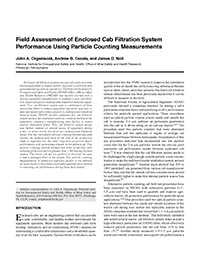Mining Publication: Field Assessment of Enclosed Cab Filtration System Performance Using Particle Counting Measurements
Original creation date: September 2013
Enclosed cab filtration systems are typically used on mobile mining equipment to reduce miners’ exposure to airborne dust generated during mining operations. The National Institute for Occupational Safety and Health (NIOSH) Office of Mine Safety and Health Research (OMSHR) has recently worked with a mining equipment manufacturer to examine a new cab filtration system design for underground industrial minerals equipment. This cab filtration system uses a combination of three particulate filters to reduce equipment operators’ exposure to dust and diesel particulates present in underground industrial mineral mines. NIOSH initially examined this cab filtration system using a two-instrument particle counting method at the equipment company’s manufacturing shop facility to assess several alternative filters. This cab filtration system design was further studied on several pieces of equipment during a two- to seven-month period at two underground limestone mines. The two-instrument particle counting method was used outside the underground mine at the end of the production shifts to regularly test the cabs’ long-term protection factor performance with particulates present in the ambient air. This particle counting method showed that three of the four cabs achieved protection factors greater than 1,000 during the field studies. The fourth cab did not perform at this level because it had a damaged filter in the system. The particle counting measurements of submicron particles present in the ambient air were shown to be a timely and useful quantification method in assessing cab performance during these field studies.
Authors: JA Organiscak, AB Cecala, JD Noll
Peer Reviewed Journal Article - September 2013
NIOSHTIC2 Number: 20043058
J Occup Environ Hyg 2013 Sep; 10(9):468-477
See Also
- The Borehole Monitoring Experiment: Field Measurements of Reservoir Conditions and Responses in Longwall Panel Overburden During Active Mining
- Clearing the Air
- Differential Pressure Response of 25-mm-Diameter Glass Fiber Filters Challenged with Coal and Limestone Dust Mixtures
- Doing the Math: The Effectiveness of Enclosed-Cab Air-Cleaning Methods Can Be Spelled Out in Mathematical Equations
- The Effect of Standing Support Stiffness on Primary and Secondary Bolting Systems
- Effects of Sintered Metal Diesel Particulate Filter System on Diesel Aerosols and Nitric Oxides in Mine Air
- Experimental Mine and Laboratory Dust Explosion Research at NIOSH
- Maximizing Air Quality Inside Enclosed Cabs with a Unidirectional Filtration and Pressurization System
- Measuring the Methane Content of Bituminous Coalbeds
- NIOSH Hazard ID 1 - Exposure to Silica Dust on Continuous Mining Operations Using Flooded-Bed Scrubbers
- Content source: National Institute for Occupational Safety and Health, Mining Program


 ShareCompartir
ShareCompartir
